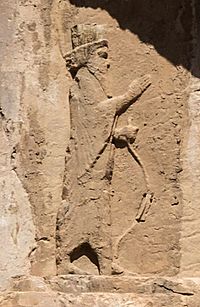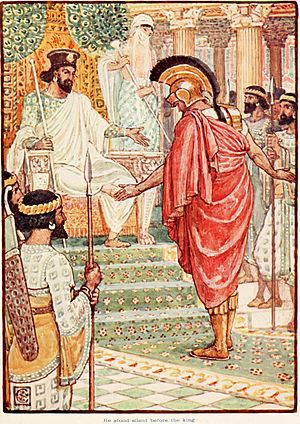Artaxerxes I facts for kids
Quick facts for kids Artaxerxes I𐎠𐎼𐎫𐎧𐏁𐏂 |
|
|---|---|
|
|

Relief of Artaxerxes I, from his tomb in Naqsh-e Rustam
|
|
| King of Kings of the Achaemenid Empire | |
| Reign | 465–424 BC |
| Predecessor | Xerxes I |
| Successor | Xerxes II |
| Born | Unknown |
| Died | 424 BC, Susa |
| Burial | Naqsh-e Rustam, Persepolis |
| Spouse | Queen Damaspia Alogyne of Babylon Cosmartidene of Babylon Andia of Babylon |
| Issue | Xerxes II Sogdianus Darius II Arsites Parysatis |
| House | Achaemenid |
| Father | Xerxes I |
| Mother | Amestris |
| Religion | Zoroastrianism |
Artaxerxes I ( Old Persian: 𐎠𐎼𐎫𐎧𐏁𐏂 Artaxšaça, "whose rule (xšaça < *xšaϑram) is through arta ("truth"); Hebrew: אַרְתַּחְשַׁשְׂתָּא, Standard ʾArtaḥšásta Tiberian ʾArtaḥšasetāʾ; Ancient Greek: Ἀρταξέρξης, romanized: Artaxérxēs) was the fifth King of Kings of the Achaemenid Empire, from 465 to 424 BC. He was the third son of Xerxes I.
He may have been the "Artasyrus" mentioned by Herodotus as being a satrap of the royal satrapy of Bactria.
In Greek sources he is also surnamed "long-handed" (Ancient Greek: μακρόχειρ Makrókheir; Latin: Longimanus), allegedly because his right hand was longer than his left.
Contents
Egyptian revolt
Artaxerxes had to face a revolt in Egypt in 460–454 BC led by Inaros II, who was the son of a Libyan prince named Psamtik, presumably descended from the Twenty-sixth Dynasty of Egypt. In 460 BC, Inaros II revolted against the Persians with the help of his Athenian allies, and defeated the Persian army commanded by satrap Akheimenes. The Persians retreated to Memphis, and the Athenians were finally defeated in 454 BC, by the Persian army led by Megabyzus, after a two-year siege. Inaros was captured and carried away to Susa.
Relations with Greece

After the Achaemenid Empire had been defeated at the Battle of the Eurymedon (c. 469 BC), military action between Greece and Persia was at a standstill. When Artaxerxes I took power, he introduced a new Persian strategy of weakening the Athenians by funding their enemies in Greece. This indirectly caused the Athenians to move the treasury of the Delian League from the island of Delos to the Athenian acropolis. This funding practice inevitably prompted renewed fighting in 450 BC, where the Greeks attacked at the Battle of Cyprus. After Cimon's failure to attain much in this expedition, hostilities ceased. Later sources argue that the purported Peace of Callias was agreed among Athens, Argos and Persia in 449 BC; however, the existence of a formal treaty between the Greek States and Persia is disputed.
Artaxerxes I offered asylum to Themistocles, who was probably his father Xerxes's greatest enemy for his victory at the Battle of Salamis, after Themistocles was ostracized from Athens. Also, Artaxerxes I gave him Magnesia, Myus, and Lampsacus to maintain him in bread, meat, and wine. In addition, Artaxerxes I gave him Skepsis to provide him with clothes, and he also gave him Percote with bedding for his house. Themistocles would go on to learn and adopt Persian customs, Persian language, and traditions.
Portrayal in the Book of Ezra and Nehemiah
A King Artaxerxes (Hebrew: אַרְתַּחְשַׁשְׂתְּא, אַרְתַּחְשַׁ֣סְתְּא or אַרְתַּחְשַׁ֗שְׂתָּא) is described in the Bible (Ezra 7) as having commissioned Ezra, a kohen and scribe, by means of a letter of decree to take charge of the ecclesiastical and civil affairs of the Jewish nation.
Ezra thereby left Babylon in the first month of the seventh year of Artaxerxes' reign, at the head of a company of Jews that included priests and Levites. They arrived in Jerusalem on the first day of the fifth month of the seventh year according to the Hebrew calendar. The text does not specify whether the king in the passage refers to Artaxerxes I (465–424 BC) or to Artaxerxes II (404–359 BC). Most scholars hold that Ezra lived during the rule of Artaxerxes I, though some have difficulties with this assumption: Nehemiah and Ezra "seem to have no knowledge of each other; their missions do not overlap", however, in Nehemiah 12, both are leading processions on the wall as part of the wall dedication ceremony. So, they clearly were contemporaries working together in Jerusalem at the time the wall and the city of Jerusalem was rebuilt in contrast to the previously stated viewpoint. These difficulties have led many scholars to assume that Ezra arrived in the seventh year of the rule of Artaxerxes II, i.e. some 50 years after Nehemiah. This assumption would imply that the biblical account is not chronological. The last group of scholars regard "the seventh year" as a scribal error and hold that the two men were contemporaries. However, Ezra appears for the first time in Nehemiah 8, having probably been at the court for twelve years.
The rebuilding of the Jewish community in Jerusalem had begun under Cyrus the Great, who had permitted Jews held captive in Babylon to return to Jerusalem and rebuild Solomon's Temple. Consequently, a number of Jews returned to Jerusalem in 538 BC, and the foundation of this "Second Temple" was laid in 536 BC, in the second year of their return (Ezra 3:8). After a period of strife, the temple was finally completed in the sixth year of Darius, 516 BC (Ezra 6:15).
In Artaxerxes' twentieth year, Nehemiah, the king's cup-bearer, apparently was also a friend of the king as in that year Artaxerxes inquired after Nehemiah's sadness. Nehemiah related to him the plight of the Jewish people and that the city of Jerusalem was undefended. The king sent Nehemiah to Jerusalem with letters of safe passage to the governors in Trans-Euphrates, and to Asaph, keeper of the royal forests, to make beams for the citadel by the Temple and to rebuild the city walls.
Children
By queen Damaspia
- Xerxes II
By Alogyne of Babylon
- Sogdianus
By Cosmartidene of Babylon
- Darius II
- Arsites
By Andia of Babylon
- Bogapaeus
- Parysatis, wife of Darius II Ochus
By another(?) unknown wife
- An unnamed daughter, wife of Hieramenes, mother of Autoboesaces and Mitraeus
By various wives
- Eleven other children
See also
 In Spanish: Artajerjes I para niños
In Spanish: Artajerjes I para niños
- Artoxares
- Ezra–Nehemiah
- List of biblical figures identified in extra-biblical sources




